Caroline Lucas, environmental campaigner and Green Party MP for Brighton Pavilion, talks to Melanie Vandenbrouck about curating an exhibition on art and the environment for the Towner Eastbourne.
What was it like to be asked to curate this exhibition by the Towner?
I received an email out of the blue, and couldn’t believe my luck! Who wouldn’t leap at the chance of immersing themselves in more than 5,000 artworks [from their collection] and having the privilege of being able to choose from them? So I felt incredibly honoured and excited, but at the same time pretty overwhelmed by the proposal. When they explained that they were introducing a programme of guest curators, it made sense that someone coming in from the outside might be able to bring a fresh set of interests to the collections and make new connections. And I must say I had a huge amount of support from Sara Cooper and Karen Taylor, the main curators.
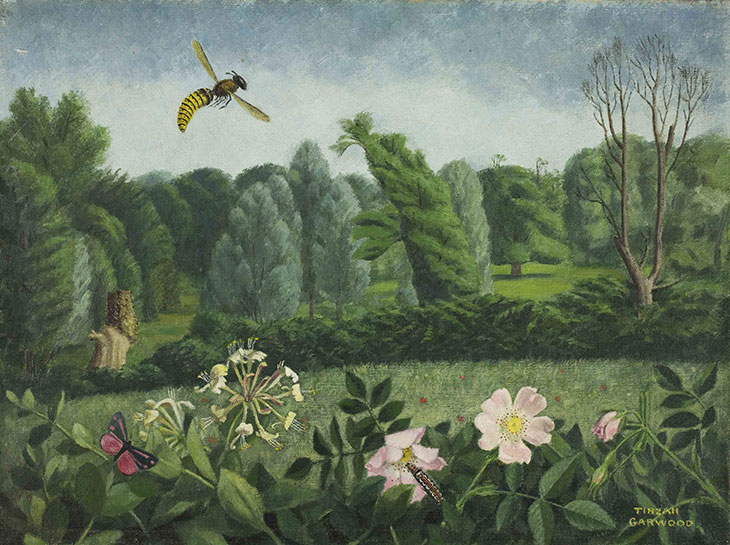
Hornet with Wild Roses (1950), Tirzah Garwood. Towner Collection, Eastbourne. © Estate of Tirzah Ravilious. All rights reserved, DACS 2018
What were your guiding principles as you made your selection?
I knew I wanted to do something about the environment and nature; that’s what gets me up in the morning and that’s what my passion is. One of the lovely things about the Towner collection is that there are so many landscapes and seascapes, a lot of them quite local, so there was a real familiarity with a part of the world I understood. But beyond nature, environment and climate being the theme, my starting point was the David Nash exhibition which opened a couple of months before mine [closes 2 February]. I feel so lucky I was able to meet him, and also visit his studio and the gallery at Capel Rhiw. It was a wonderful immersion in his work and in his thinking. And I was struck by the fact that his exhibition is a retrospective – 200 seasons, 50 years looking back at his work. So my own starting point became: what do we know about the next 200 seasons, what can we be certain of, do we even have 200 seasons of safe life on this planet? That question led me to choose landscapes and seascapes, many of them local, many familiar, but now with a question mark over them. What happens to this over the next 50 years? These outlines of landscapes and seascapes that have long been taken for granted can no longer be assumed to be permanent and unchanging.
I was also just drawn to the things I liked. The painting by Nick Johnson of his lurcher is there just because I loved him. But pleasure is part of the point, too – rekindling a love for our extraordinarily beautiful Earth seems to me to be important. The arts in a wider sense remind us that we can change, that human beings are endlessly creative, and that when we choose to, we can make things happen.
Your exhibition opens with Wolfgang Tillmans’ gasp-inducing End of Land I [from 2002], a person lying flat on the ground on the edge of the cliffs at Beachy Head. While not shot in reference to the climate crisis, the photograph in the context of this show seems to remind us that we are now, metaphorically, on the cliff’s edge, on the brink of ecological collapse.
It is a bit of a punch in the stomach in a way. It is so monumental and so vertiginous. It’s really hard not to read it metaphorically, even if it weren’t for the climate crisis, that sense of being on the edge of things changing. That’s what I found again and again in some of the works that I was choosing, that interesting point about where land and sea meet. Or in the sharp edges of Margaret Benecke’s Glacier Forms [from 1936]. What happens at those interfaces. And it feels hard not to feel the weight of metaphor around that. The name of the exhibition seems obvious perhaps, but in so many ways it feels like we are on the brink of a different world, and that unless we take urgent action, that world will be a much more dangerous and less hospitable place.
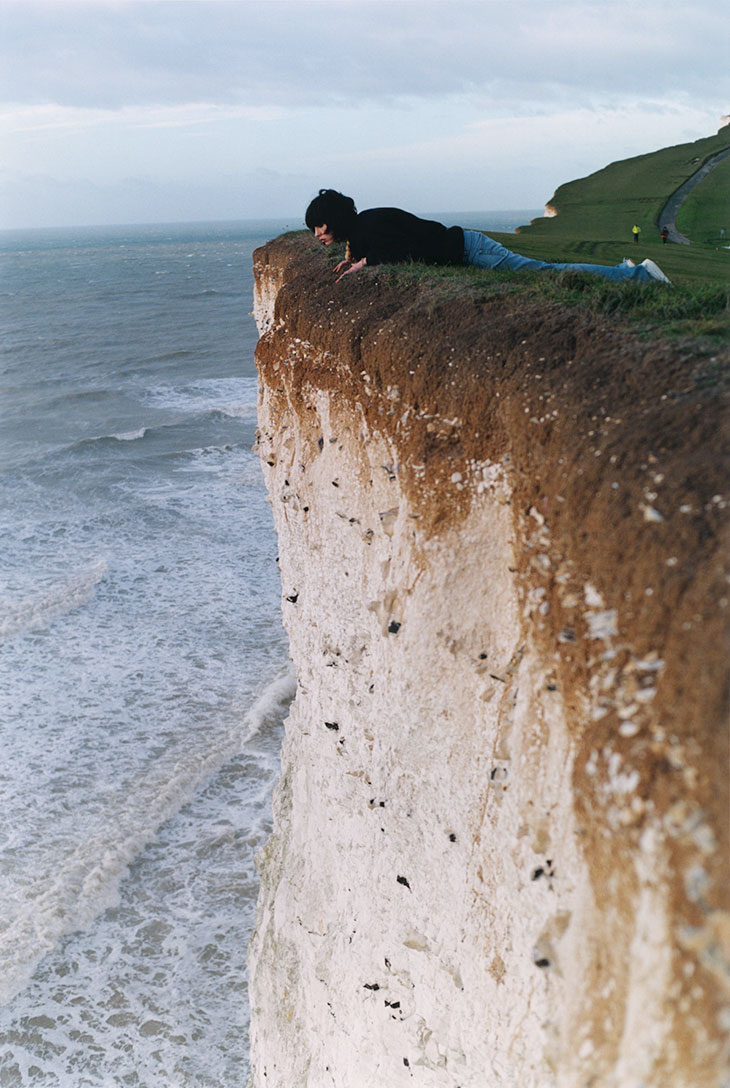
End of Land I (2002), Wolfgang Tillmans. Towner Collection, Eastbourne. Courtesy Maureen Paley, London; © Wolfgang Tillmans
What role do you think art and artists can play in the climate crisis?
The thing I go to bed thinking about every night and I wake up thinking about every morning is: How do we get people to recognise the need for urgent action? What prevents it from happening? I spend my life banging on about the policies that we need to get us off the collision course that we are on with climate catastrophe, the fact that we have only ten years left according to the Intergovernmental Panel on Climate Change to halve global emissions. We know this stuff. We don’t lack facts. We don’t lack evidence. What we lack is political will.
It seems to me that many people have not made that emotional connection, and you can see why, because who wants to immerse themselves in that horror, really? Yet we need some way of being able to do that safely, and constructively. So paradoxically perhaps at the time when the case for urgent action becomes most apparent, being able to address some of these issues through art, albeit obliquely, feels apt. And that’s what makes me feel, in a sense, that art is more important than ever – because it can reach people that wouldn’t otherwise engage with these issues, and has the potential to generate change.
Exploring these ideas is what led to my contribution last year to the book Letters to the Earth. My letter is addressed to artists and writers and poets and musicians, asking for help: ‘Will you help us to protect this precious earth, to inspire us to believe that it’s not too late to act, to show us that each and every one of us can make a difference, and to convince us that the system can still be changed?’
One painting, Charles Knight’s Ditchling Beacon, is linked to Kenneth Clark’s ‘Recording Britain’, a large-scale wartime scheme commissioning artists to record the landscape of Britain in a time of unprecedented change. Do you feel like we need a similar project now?
This idea really speaks to me. Within the environmental discourse, there is major concern about ‘shifting baselines’. Essentially this refers to the fact that knowledge is lost about the state of the natural world because people don’t perceive changes that are taking place over time; I don’t remember what my grandmother would have known when she was walking in the fields around Worcestershire where I was brought up, because I only know it from my starting point, my own baseline.
In my lifetime alone we have wiped out half of the wildlife in this country – in my lifetime, we’ve done that! We’ve lost abundance – abundance of moths and butterflies, flies and sparrows. Birdsong has thinned, the buzz around the flowers is quieter and there is less colour in the fields. One of my favourite books is Michael McCarthy’s The Moth Snowstorm. In it, he reminisces that when he was young – and I remember this – if you went for a drive with your parents in the dark, when you arrived at your destination the windscreen would be covered in little insects, because there were so many around. That doesn’t happen anymore. He refers to this loss of abundance as ‘the great thinning’. It worries me that unless we pay attention, unless we celebrate what we have, we won’t appreciate what we are losing and won’t preserve it.
Ditchling Beacon (c. 1930), Charles Knight. Towner Collection, Eastbourne. © The Artist’s Estate
I was particularly moved by your selection of photographs from Clare Richardson’s Harlemville series…
I was struck that Richardson spent time among the small community of Harlemville in North America, which lives according to Rudolph Steiner’s education principles, where the focus is on creativity, imagination and nature. The photographs felt very nostalgic, conjuring a time and a place when kids were much more engaged with the natural world. Young people have lost some of that connection, particularly in countries like the UK where they spend far less time outdoors.
The American writer Richard Louv, who wrote Last Child in the Woods, says that we won’t protect what we don’t love, and we won’t love what we don’t know. That really resonated with me, and led to my campaigning alongside writer and broadcaster Mary Colwell for a new GCSE in Natural History, coming from that exact same sense that we are losing so much of what should be familiar to us. It would teach young people to identify, monitor and record the life around us – to know about migration and invasion of species, for example. To understand how the seasons affect wildlife and how that is changing.
The 2007 edition of the Oxford Junior Dictionary famously dropped words describing nature – like acorn, ash, blackberry, bluebell, conker, kingfisher, weasel and wren – and replaced them with words like chatroom and broadband… That felt deeply symbolic: if we are to try to restore the natural world, we need the language to describe it, and if such words are taken away that is truly worrying.
Seen in the context of an exhibition raising awareness about climate change, Tirzah Garwood’s Hornet with Wild Roses and Orchid Hunters in Brazil [(both 1950)] seemed to raise interesting ideas about the local and the planetary. What made you choose this pairing?
What interested me was the perspective, which is a bit odd isn’t it? The hornet is massively out of proportion, and the hunters are tiny compared to the jungle around them. So for me it was more about appreciating the design, and the colours, and the richness. And the paying attention: to see that hornet right up close and to see that detail foregrounded – something that would normally be in the background, and not paid attention to. Similarly, in the Orchid Hunters, despite the title, the human beings are fairly incidental to the painting.
That sense of perspective, paying attention to things we don’t necessarily pay attention to so much, is what also spoke to me with Jonathan Monk’s Blue without hidden noise [(2003)]. It takes quite some time to wait for all 69 slides to click through the projector carousel. I was interested in my own reaction being, ‘Oh hurry up!’. But actually, no, don’t hurry up, let me slow down and genuinely pay attention. They are ostensibly similar images of winter treescapes, but they’re each different. Even the circle of the projection reminded me of looking through a microscope or a telescope, encouraging close looking.
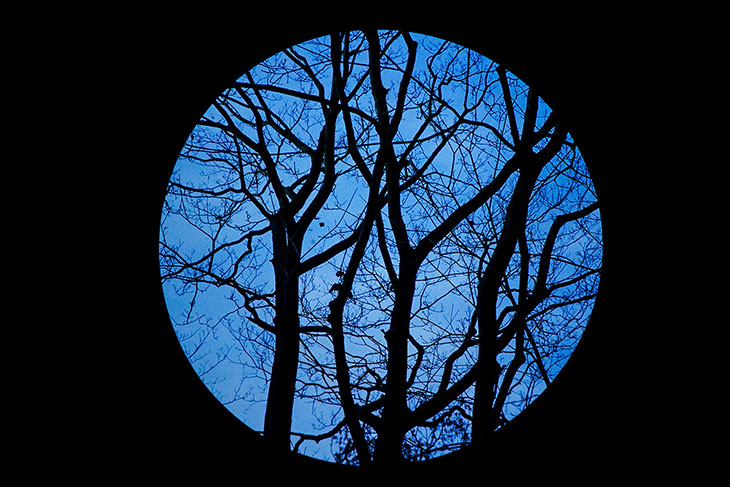
Installation view of Jonathan Monk’s Blue without hidden noise (version 2) (2003), in the Towner exhibition. Towner Collection, Eastbourne. © the artist
Tell us about your ‘wall of trees’ – a selection of paintings, prints, photographs and drawings, from Eric Ravilious to Mircea Cantor via Duncan Grant and others.
The wall of trees, in a way, was a tribute to David Nash, but there is also a very hopeful part to it. I have been doing a lot of reading about trees recently. They sustain us spiritually and emotionally – in all the great religions they have a special place – and we are also learning a lot more about how trees are so vital to us on a literal, physical level in terms of sequestering the carbon, cleaning the air, as a counterpoint to pollution, enhancing our well-being, and so forth… But the bit that excites me, and that’s what Jennifer Dickson’s etchings [from 1960 and ’61], Night Trees and Tree Structure, put me in mind of, is the emerging science about how trees communicate with one another via underground fungal networks, allowing them to distribute sugars and nitrogen and phosphorus between them. A dying tree might divest its nutrients into the network to the benefit of the community, for example, or a struggling tree might be supported with extra resources by its neighbours. What we’re looking at in a forest is not single trees, but a forest community, connected by literally miles of super-fine threads called hyphae, that fungi send out through the soil.
The phrase ‘species loneliness’ has been coined – for me, an incredibly powerful term for the intense solitude we’re fashioning for ourselves as we strip the Earth of the other life with which we share it. As the writer Robert Macfarlane says in his new book, Underland, if there is human meaning to be made of the ‘wood wide web’ it is surely that what might save us as we move forwards into the precarious unsettled centuries ahead is collaboration: mutualism, symbiosis. And that gives me hope.
Was this why you also included a participatory space in the exhibition, inviting visitors to share their own declaration, challenge or pledge towards a ‘BRINK climate manifesto’?
If part of the aim of the exhibition is to challenge people to ask different questions about familiar landscapes, and if part of the role of art is to stimulate conversation that might otherwise not happen, then it has to be a two-way process, it can’t just be an art gallery acting like a lecture hall. There needed to be an interaction. So it was partly about celebrating the fact that young people are such a source of hope – there are a couple of placards in particular, from a young climate striker I met in Eastbourne. But it was also about suggesting things that people can do, and inviting them to share their own ideas, because there is no point raising questions about the destruction of the environment without giving people some sense of agency. The idea is to collate some of the visitors’ responses at the end of the exhibition, and do something with it, even if that’s just a letter to the environment minister saying ‘these are the concerns that have been raised at this particular gallery at this time’.
What do you see as the role of the museum or art gallery in citizens’ action?
As a source of inspiration, restoration and connection – and as a spur to action. Because there is such urgency to this. As the American climate campaigner Bill McKibben says, winning slowly is the same as losing. The biggest threat is not the climate deniers but the climate delayers. [Bringing greenhouse gas emissions to] net zero by 2050 is just too late. Greta Thunberg says we’re living in a house that’s on fire – she’s right. But when you dial 999 and ask for a fire engine, you don’t ask it to come in 30 years’ time – you ask for it right now.
‘BRINK: Caroline Lucas curates the Towner Collection’ is at Towner Eastbourne until 10 May.
Unlimited access from just $16 every 3 months
Subscribe to get unlimited and exclusive access to the top art stories, interviews and exhibition reviews.

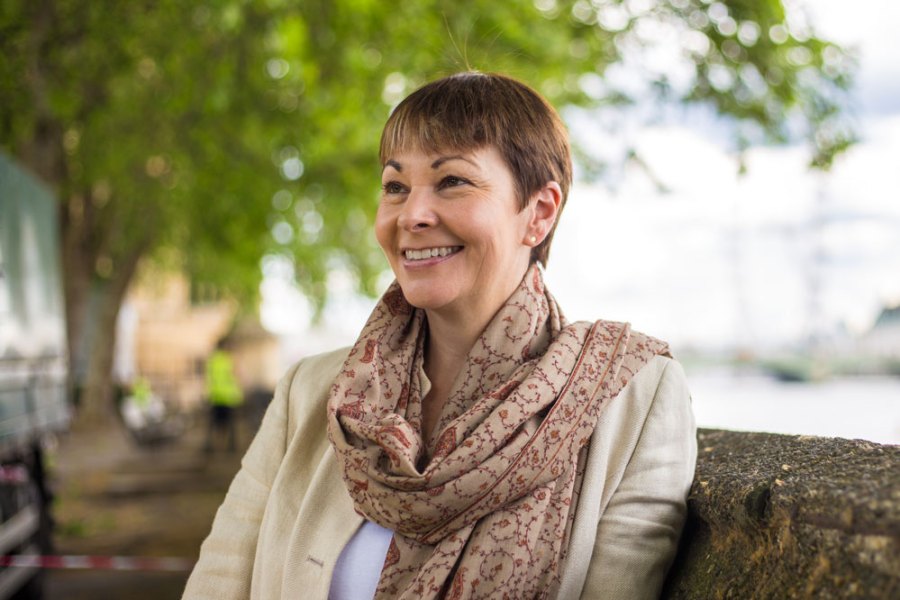
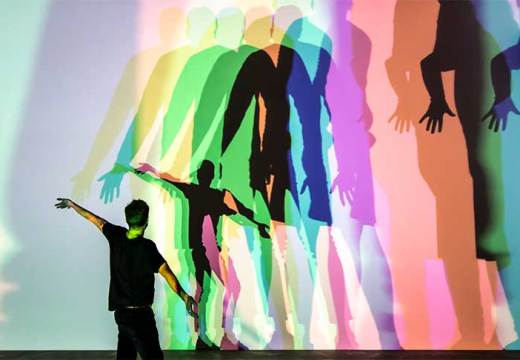
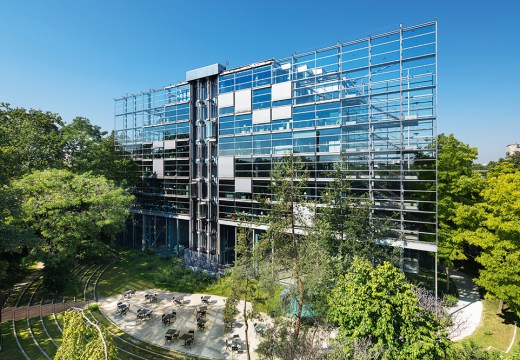
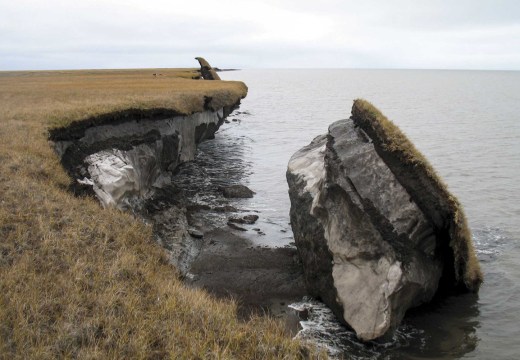









![Masterpiece [Re]discovery 2022. Photo: Ben Fisher Photography, courtesy of Masterpiece London](http://www.apollo-magazine.com/wp-content/uploads/2022/07/MPL2022_4263.jpg)
Has the Fitzwilliam lost the hang of things?